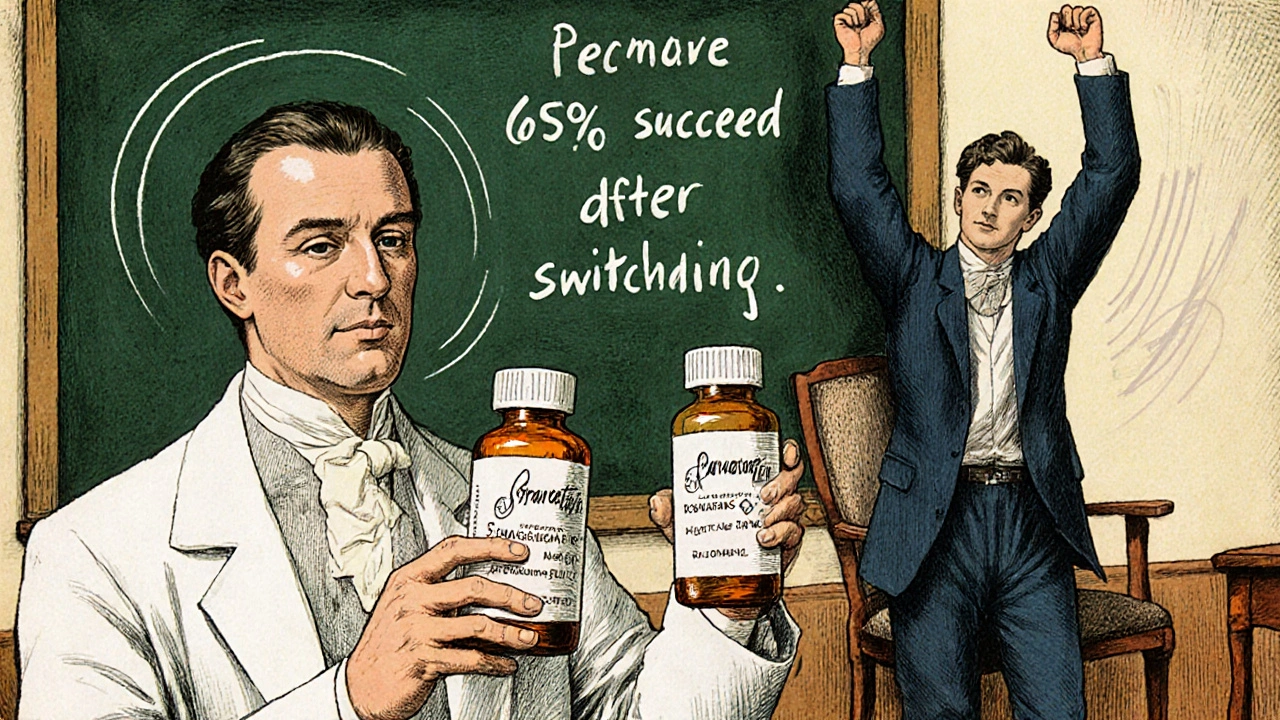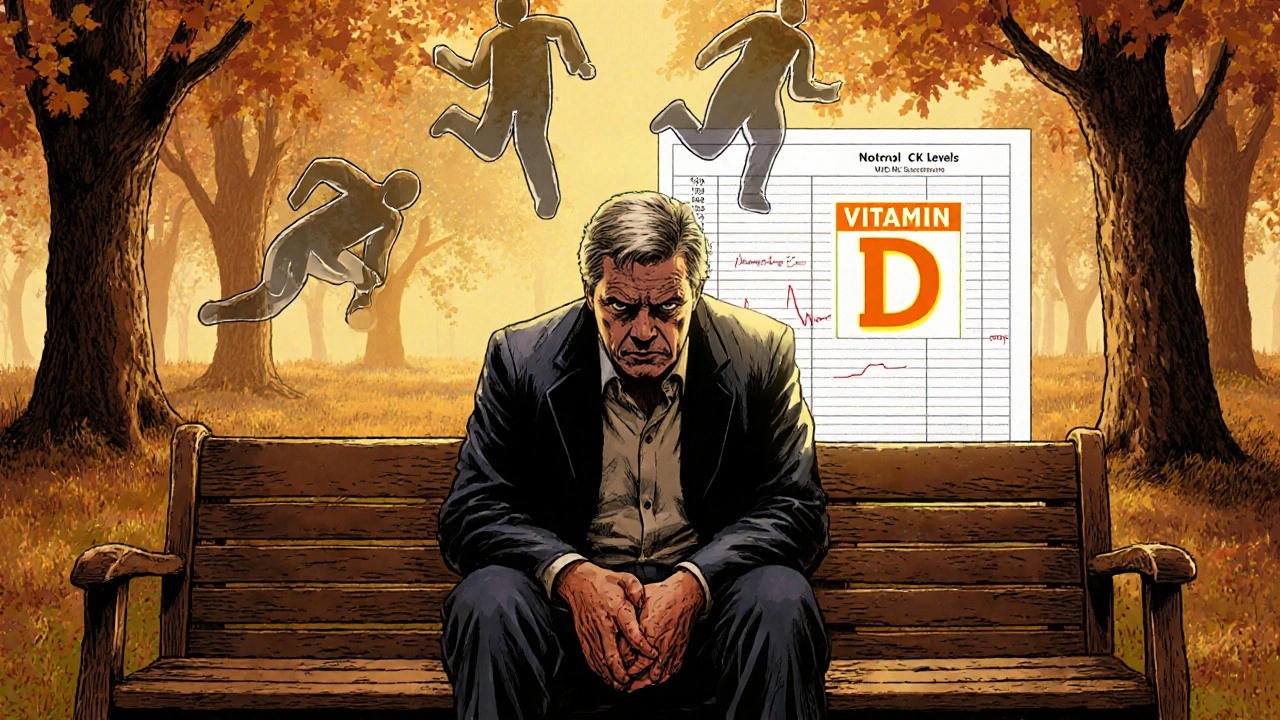Why Your Muscle Pain Might Not Be From Statins
Many people stop taking statins because of muscle pain-aching thighs, stiff shoulders, or weakness when climbing stairs. But here’s the hard truth: most of that pain isn’t actually caused by the statin.
The National Lipid Association updated its definition in 2022 to say true statin intolerance means you can’t take two different statins without symptoms. One at the lowest dose, another at any dose. And the symptoms must go away when you stop the drug and come back if you try it again. Only then is it real statin intolerance.
Studies show 72% to 85% of people who think they’re intolerant actually have something else going on. Osteoarthritis. Vitamin D deficiency. Fibromyalgia. Even just getting older. In one study, nearly 30% of people with muscle pain had vitamin D levels below 20 ng/mL. Fix that, and the pain often disappears.
The SAMSON trial was a game-changer. People were given statins, placebos, and no pills-all in random order. They reported muscle pain just as often during the placebo phase as the statin phase. That’s the nocebo effect: expecting side effects makes you feel them, even when there’s no drug involved.
What Real Statin Muscle Symptoms Look Like
If you do have true statin-associated muscle symptoms (SAMS), they’re not random aches. They’re usually:
- Symmetrical-both legs, both shoulders
- Proximal-thighs, buttocks, back, shoulders
- Described as heaviness, stiffness, or cramping-not sharp pain
Most people feel it within 30 days of starting or increasing the dose. Eighty-three percent of cases show up in that first month.
Here’s what doctors look for: Can you stand up from a chair without using your arms? Can you lift your hands above your head? If you need more than 10 seconds to stand or can’t raise your arms, that’s a red flag.
And here’s something most don’t know: 89% of people with SAMS have normal or only slightly elevated creatine kinase (CK) levels. If your CK is more than 10 times the normal level, that’s myositis. Over 40 times? That’s rhabdomyolysis-a rare, dangerous condition. The FDA says only about 1.5 to 2.4 cases of rhabdomyolysis happen per million statin prescriptions. That’s less than one in every 500,000 people.
Why One Failed Statin Doesn’t Mean You’re Intolerant
Too many people get labeled as statin-intolerant after trying just one statin-often simvastatin or atorvastatin-and then quit. But that’s not enough.
Research shows 65% of people who can’t tolerate one statin can take another just fine. Why? Because statins are not all the same. Lipophilic statins (like simvastatin, atorvastatin) cross into muscle tissue more easily. Hydrophilic ones (pravastatin, rosuvastatin) don’t. That’s why switching to rosuvastatin or pravastatin often works.
Low-dose atorvastatin (10mg) has an 89% tolerability rate. That’s higher than many people think. And if you can’t handle daily dosing, try every-other-day or even weekly dosing. A 600mg weekly dose of rosuvastatin cuts LDL by nearly half in 68% of patients who stick with it.
Don’t give up after one try. Try two different statins. Give each a fair shot-six to eight weeks at a low dose. Then reevaluate.

Non-Statin Options That Actually Work
If you truly can’t take statins, you’re not out of options. There are five proven alternatives:
- Ezetimibe (10mg daily): Lowers LDL by 18%, taken alone or with a low-dose statin. Tolerability is 94% at 12 months. It’s cheap, safe, and works well.
- Bempedoic acid (180mg daily): Reduces LDL by 17%. It’s activated in the liver, not muscles, so it rarely causes muscle pain. In trials, 88% of people kept taking it.
- PCSK9 inhibitors (evolocumab, alirocumab): Injected every two weeks. Cuts LDL by 59%. Adherence is 91%. The catch? Cost-around $5,800 a year. Insurance often requires prior authorization, and 37% of requests get denied.
- Bile acid sequestrants (colesevelam): Pills that bind cholesterol in the gut. Lowers LDL by 15-18%. But they cause bloating and constipation in 22% of users.
- Inclisiran: A twice-yearly injection that silences a gene involved in LDL production. Reduces LDL by 50%. Approved in 2023, still new but highly effective.
Real-world data shows most people need to try 2.3 different strategies before reaching their LDL goal. It takes 3 to 6 months. But over 76% of patients eventually get there.
What About CoQ10, Diet, and Exercise?
Many people turn to CoQ10 supplements, hoping to ease muscle pain. The science? Weak. Double-blind trials show only 34% report any benefit. It’s not a reliable fix.
Diet and exercise? Essential-but not enough on their own. A Mediterranean diet with olive oil, nuts, and fish lowers LDL by 10-15%. Regular walking or cycling helps, too. But if your LDL is above 190 mg/dL or you have heart disease, you still need medication.
Don’t replace proven drugs with supplements. Use diet and movement to support your treatment, not replace it.

What Happens If You Just Stop Statins?
Stopping statins because of muscle pain sounds like relief. But it’s risky.
Studies show 45% to 60% of statin prescriptions are stopped within the first year. Muscle pain is the top reason. But here’s the cost: people who stop statins without switching to another effective therapy have a 25% higher chance of having a heart attack or stroke.
And the financial toll? Inappropriate discontinuation adds $1,800 per patient per year in extra healthcare costs.
Most patients who stop statins report increased anxiety. They know they’re at risk. They just don’t know what else to do.
The good news? With the right approach, over 90% of people labeled as statin-intolerant can reach their cholesterol goals. It just takes patience, the right testing, and the right alternatives.
What’s Next for Statin Intolerance?
Genetic testing is coming fast. The SLCO1B1 gene variant *5 and *15 increases myopathy risk by 4.5 times. By 2025, doctors may test for this before prescribing statins-especially for people with family history or muscle issues.
Oral PCSK9 inhibitors like MK-0616 are in late-stage trials. If approved, they could replace injections and cut LDL by 61% with 87% adherence.
The goal isn’t to make everyone take statins forever. It’s to make sure no one stops because they were misdiagnosed. Or because they didn’t know other options existed.
Can I take statins again after stopping because of muscle pain?
Yes-but only after a proper evaluation. If your symptoms went away after stopping, try a different statin at a low dose. Hydrophilic statins like pravastatin or rosuvastatin are better tolerated. If symptoms return, that’s true intolerance. If they don’t, you were likely misdiagnosed.
Is muscle pain from statins always accompanied by high CK levels?
No. In fact, 89% of people with statin-related muscle symptoms have normal or only mildly elevated CK levels. High CK (over 10x normal) is rare and signals something more serious like myositis. Normal CK doesn’t rule out SAMS.
What’s the best non-statin option for lowering LDL?
For most people, ezetimibe is the first-line non-statin. It’s affordable, safe, and lowers LDL by 18%. If you need more, bempedoic acid adds another 17% reduction with minimal muscle side effects. For high-risk patients, PCSK9 inhibitors or inclisiran offer the strongest LDL drops-up to 60%.
Why do some doctors say statins are safe but I still feel awful?
Because the average risk is low-but not zero. For most people, muscle pain isn’t from the statin. But for some, it is. The key is not to assume your pain is or isn’t related. Get tested: check vitamin D, thyroid, and CK levels. Try a different statin. Rule out other causes. Don’t stop without a plan.
Can I take a lower dose of statin and still be protected?
Yes. Low-dose atorvastatin (10mg) reduces LDL by 32% and is tolerated by 89% of patients. Even intermittent dosing-like 600mg rosuvastatin once a week-can lower LDL by nearly half. You don’t need a high dose to get benefit. The goal is to find the lowest effective dose you can tolerate.


Erika Puhan
November 8, 2025 AT 05:16Let’s be real-this whole statin intolerance narrative is being weaponized by Big Pharma to keep people on expensive drugs. The SAMSON trial? Classic placebo/nocebo design. If people report pain on placebo, it’s not that the statin is safe-it’s that their brains are primed to feel pain because they’ve been scared into believing statins are toxic. Meanwhile, CK levels are ignored like they’re irrelevant. You can’t just dismiss symptoms because the biomarker is ‘normal.’ Human experience isn’t a lab report.
And don’t even get me started on ‘try another statin.’ That’s like saying ‘if one brand of aspirin gives you a rash, just try a different one.’ Some people are just sensitive. Not everyone is a statistic. Your 89% tolerability rate doesn’t mean squat to the 11% who are suffering.
Edward Weaver
November 9, 2025 AT 15:07Bro, if you can’t handle a statin, maybe you’re just lazy. I’ve been on Lipitor for 12 years. Never had a single ache. You think your thigh pain is from the pill? Nah. You’re sitting on the couch eating nachos and scrolling TikTok. Get off your butt. Lift something. Walk. Vitamin D? Yeah, maybe you’re deficient because you never go outside. America’s got a weakness problem, not a statin problem.
And those PCSK9 injectables? $5,800 a year? That’s why we need to stop letting people cry about meds. If you can’t afford it, tough. Eat better. Stop being a medical tourist. Statins work. Period. End of story.
Lexi Brinkley
November 9, 2025 AT 18:25OMG this post is literally a GAME CHANGER 😭 I’ve been off statins for 2 years bc of muscle cramps and I thought I was doomed… but now I’m gonna try rosuvastatin?? 🙌 and ezetimibe?? I’m already googling my local pharmacy 😍 also CoQ10 is a scam?? 😳 I’ve been taking 200mg daily for 3 years… RIP my wallet 💸
Kelsey Veg
November 11, 2025 AT 03:37so like… i stopped statins bc my legs felt like concrete and i thought it was the pill but turns out i was just low on vit d?? 🤯 i mean… i’m not even mad. i just spent 6 months feeling like a 90 year old and it was all because i didn’t get my blood work done??
also… bempedoic acid? i’ve never heard of it. is that the one you take like a pill? or is it like a shot? i’m too lazy to read the whole thing again but i’m gonna try it. also i think i’m allergic to the word ‘hydrophilic’ lol
Alex Harrison
November 12, 2025 AT 11:24I’ve been through this. Took simvastatin for six months, felt like I was dragging my legs through mud. Went to my doc, they said ‘it’s probably the statin.’ I quit. Then my cholesterol went through the roof. Back to the doc, they said ‘try pravastatin.’ I did. No issues. Zero pain. Turned out I just got unlucky with the first one.
Don’t assume your pain is from the drug. Get tested. Check your vit D. Check your thyroid. Check your CK. Don’t just quit. And yeah, low dose atorvastatin works fine for most people. I take 10mg. My LDL’s at 85. I feel great. It’s not about being tough. It’s about being smart.
Also, the every-other-day thing? Works. My cousin does 40mg every other day. LDL down 40%. No pain. No drama. Just science.
Jay Wallace
November 13, 2025 AT 19:58Let’s be crystal clear: The notion that ‘most muscle pain isn’t from statins’ is a dangerous oversimplification propagated by lipidologists who’ve been funded by Big Pharma since 2015. The SAMSON trial? Small sample size. Short duration. No long-term follow-up. And what about subclinical myopathy? CK levels are notoriously insensitive-they don’t capture mitochondrial dysfunction or sarcoplasmic reticulum disruption. You can’t reduce human physiology to a single biomarker.
Furthermore, the ‘try another statin’ mantra ignores pharmacogenomics. SLCO1B1*5 isn’t just a variant-it’s a biological red flag. Why aren’t we testing for it preemptively? Why are we forcing people to suffer through trial-and-error? And yes, ezetimibe and bempedoic acid are useful-but they’re not replacements. They’re Band-Aids on a hemorrhage.
And don’t get me started on ‘diet and exercise.’ If you think a kale smoothie fixes an LDL of 220, you’ve never met a familial hypercholesterolemia patient. This isn’t a lifestyle problem. It’s a genetic one. And the system is failing.
Alyssa Fisher
November 15, 2025 AT 16:47What strikes me most isn’t the science-it’s the emotional toll. People aren’t just stopping statins because of pain. They’re stopping because they feel unheard. The medical system has told them for decades: ‘It’s all in your head.’ Then when they finally find relief, it’s not because the drug was wrong-it’s because they were finally listened to.
There’s a deeper truth here: medicine treats symptoms, not stories. We measure CK, not courage. We count LDL, not loneliness. The person who can’t climb stairs isn’t just deficient in vitamin D-they’re deficient in hope. And that’s what gets lost in all these percentages.
So when we say ‘89% of people tolerate statins,’ we’re not just talking about biochemistry. We’re talking about lives. The woman who cried because she thought she’d never walk her daughter down the aisle. The man who stopped driving because his legs gave out. They’re not ‘exceptions.’ They’re the reason we need better diagnostics, not better stats.
Maybe the real statin intolerance isn’t in the muscle-it’s in the system that refuses to see the person behind the lab result.